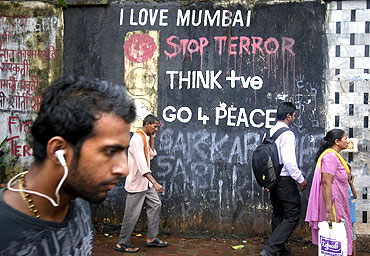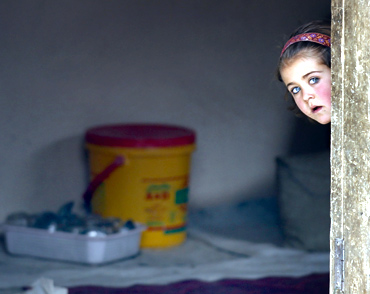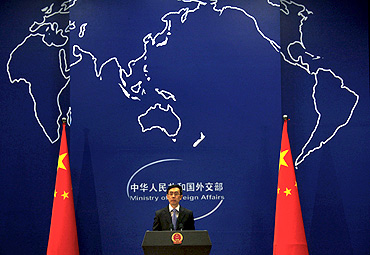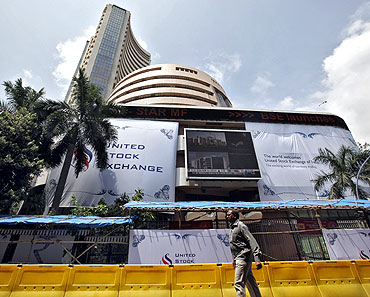Photographs: Larry Downing/Reuters
At a dialogue between the Ministry of External Affairs, International Institute for Strategic Studies and Institute for Defence Studies and Analyses held in Delhi recently, Foreign Secretary Ranjan Mathai spoke extensively on the topic of Forging Stability in Asia. He talked about the challenges and goals that India faces while trying to strengthen its ties across the Asian continent.
"Sometimes it is useful to spend a minute on definitions. To us in India, Asia has always meant the entire continent, not just the Eastern part of it as seen from across the Pacific. At the Asian Relations Conference in March 1947, Prime Minister Jawaharlal Nehru presciently spoke of a rising Asia and welcomed delegations from China, Egypt and the Arab world, Iran, Indonesia & Indo-China, Turkey, Korea, Mongolia, Thailand (Siam), Malaya, Philippines, Central Asia (he referred to the Soviet Asian republics), all our neighbours, Australia and New Zealand.
This is a vast canvas, and it needs retelling that India is in a sense a meeting point of influences of West, North, East and South East Asia. The theme of forging stability across such a vast expanse requires a look at whether Asia can be considered a single strategic entity. Perhaps not, despite decades of globalisation.
Stability in other regions has essentially been forged by what we can call architecture; the creation usually by general consent, of structures of regional dialogue and cooperation. These arrangements help either subsume, resolve or put aside bilateral differences, within a construct aimed at collaboration on issues of general interest or towards achievement of a common vision of the general interest.
The EU was traditionally considered the exemplar. After the recent East Asia Summit, the ASEAN is probably an equally good example of the search for stability through architecture.
We are supposed to be in a post-Westphalian world in which globalisation has reduced classical identity of States as autonomous entities. Recent events suggest, however, that the nation state remains the primary unit of international politics, and regional architecture cannot end competition among nation states; it can however moderate it through the quest for common interests.
It also appears that requirements for stability do have a substantial constituency; even in an era of mobilised, politically active populations, the dangers of unrestricted competition are increasingly recognised. Also recognised is that multilateral constructs provide avenues for compromise that may not be politically saleable on purely bilateral levels.
'Asymmetric war is actually war by other means'
Image: A vendor sells masks of Al Qaeda founder Osama bin LadenPhotographs: Sean Yong/Reuters
I do not wish to ramble on a theory of international politics. Your sessions focus on asymmetric warfare, stability in Pakistan and Afghanistan and engaging a rising China. So let me touch on these themes within the overarching idea of stability in Asia.
Asymmetric war is actually war by other means (I say this with caution because this is a field for experts). But such war is possible because of the balance created by mutually assured destruction, or because of the difficulty of finding the appropriate targets to respond to. Hence state sponsored terrorism is a form of asymmetric warfare. As the range and firepower of terrorists increase, the capacity of asymmetric warfare to endanger international security increases. The ultimate danger of nukes falling into the hands of terrorists needs the attention of all those concerned about stability across the globe.
Let me turn to the topic of stability in Pakistan and Afghanistan. This area is currently the focus of much of the world as the US and ISAF begin their countdown to the transition in 2014. Stability in Afghanistan and Pakistan, on the border between them, and in the regions abutting them are of vital importance to the countries directly involved; and the perceived outcome of the ten years' war and reconstruction efforts (the latter to which we have contributed) hinges on the maintenance or otherwise of stability in these regions.
The Istanbul Conference on November 2 sought consensus for an architecture, built on a concept of economic cooperation in a region stretching from Turkey to South Asia and Central Asia to the Gulf passing through Afghanistan which was described as the "heart of Asia". This (along with political elements) would be taken forward at Bonn in December when one can expect to hear more on what US Secretary of State Clinton described in India in July, as the New Silk Route.
For a moment this idea transports us back in time to an era when the Silk Route was an important part of the relationship between Europe, Asia and Africa for several centuries. Extending some 6000 kilometers with mostly overland (but also some sea) routes, the Silk Route was not only important for the exchange of goods and precious metals, but also for the spread of ideas and knowledge. It was, in fact, a major factor linking the developments within the great civilizations of India, China, Persia, Egypt and Rome. There was no conception of a strategic interlinking of all these regions, hence the role of the Silk Route in maintaining stability is uncertain.
'Today, no one is immune from terrorism'
Image: Pedestrians walk past graffiti that was painted after the 26/11 attacks outside a crematorium in MumbaiPhotographs: Danish Siddiqui/Reuters
The metaphor of the Silk Route (by whatever name) could be a useful one today, especially for those seeking common structures to lock in the kind of common interests that can foster Asian stability. A new Silk Route in Asia seeks to highlight the synergies between us, and the acceptance of interdependence that has not only become part of our lives, but which could give us competitive advantages for intra-regional trade and in dialogue with the world outside. None of this will be cheap. There will be a requirement for deep pockets, but the outcomes could be very positive.
Nehru hinted at the idea of Silk Route earlier in 1947, when he said "one of the notable consequences of European domination of Asia has been the isolation of Asian countries from each other. India had contacts and intercourse with her neighbour countries in the North West, North East, and East and South East Asia. With the coming of British rule these contacts were broken off and India was completely isolated from the rest of Asia. The old land routes ceased to function and our chief window to the world looked out to sea routes which led to England".
That we should be talking of "New Silk Route" even today six decades later, when there has been ample time to recreate old routes, suggests that political obstacles apart, maritime routes are, in fact, quite natural to us in Asia and must be part of any architecture we build. For us in India, the New Silk Route is another name for connectivity we seek to Central Asia and beyond. But with apologies to Bismarck, we are both a land rat and a water rat. If I were to look at the prospects for stability in Asia in connection with Afghanistan, I would add Iran to the list of countries needing to be discussed.
Security and Terrorism
Terrorism is now recognised as one of the greatest scourges of our times and a serious source of instability in regions across Asia and the wider world. Earlier in the 1980s and 1990s, it was easy for the outside world to watch as India went through trials of terrorist fire. Today, no one is immune from terrorism emerging from the same swamps that produced the terror groups targeting India. There is also a growing recognition that while India has suffered grievously, it has preserved the values of democracy and secularism at home and acted with a great sense of responsibility abroad. Such preconditions for stability are less assured in other countries.
In a new emerging world, it is, of course, necessary to find solutions to terrorism, beyond the obvious, to understand the contexts rather than to give one- size-fits-all solutions. But concerted international efforts to counter terrorism and to pressurise those who provide them safe haven, must continue and become the norm in policy making. Institutional mechanisms of states must find ways to deal with subterranean and ideological regional groups, and the asymmetric warfare resorted to by some states. The CCIT at the UN is one place to start.
'India and Afghanistan are strategic partners'
Image: A girl looks at US soldiers during a security mission in Wardak province, eastern AfghanistanPhotographs: Umit Bektas/Reuters
South Asia
In our search for stability we have tried to help Afghanistan in nation building. We have also engaged with Pakistan to maintain a structure of normalised state relations. There have been some modest successes as seen in the move towards trade normalisation. There is today, more successfully, a greater degree of stability in countries like Bangladesh, Bhutan, Maldives and Sri Lanka. There has also been considerable progress in India's relationship with Bangladesh in dealing with outstanding problems, including settling the border, security, sharing of river waters and increase in trade linkages. In fact, progress with Pakistan and better relations among and with countries in South Asia could leapfrog the SAARC region into a high economic growth trajectory.
The potential of the dynamic SAARC market is considerable with the Indian economy growing at a steady rate of about eight per cent per annum. With greater assistance to other countries in South Asia from India, I think we could create opportunities for inter-linkages for stability and economic growth. The destiny of South Asia to some extent lies within. SAARC provides a platform to aim for a higher calling even as we try to resolve our differences.
Central, West & East Asia
Afghanistan and the Central Asian region are not new areas for Indian engagement. India and Afghanistan are not just neighbours, joined together by history and civilisational contacts stretching over millennia, but we are also strategic partners. Our close relations based on cultural affinities, the shared values of multi-ethnicity and pluralism and the common quest of our peoples for peace and development have ensured that the relationship between our two peoples remains warm and friendly.
The strongest testimony of this is reflected in our reconstruction and development assistance to Afghanistan. Continuing aid and assistance to Afghanistan is a major strategy of our engagement with Afghanistan. This includes an important agreement for capacity building of Afghan working in a new economy, for the civil services and security forces. Whether you call it a New Silk Route or simply connectively through links of trade, transport and energy, the potential of the routes and networks that can emerge from regional cooperation through Afghanistan would not just be economically beneficial but confidence building measures. In the run up to 2014 and beyond, there will be scope for expanding the networks to link with other arrangements that we could consider after India's full participation in the SCO.
'China, India likely to be both competitive and complementary'
Image: China's Foreign Ministry spokesman Liu Weimin listens to a question during a news conference in BeijingPhotographs: David Gray/Reuters
West Asia
The upsurge that began in Tunisia in early 2011 has transformed West Asia. The changes set in motion in early 2011 still echo in the region: more regions are affected, more regimes have fallen, and among those which have survived, many have been forced to adopt new policies. Taken together, these changes herald an epochal shift primarily in the Arab world, possibly one of the most significant geo-political developments of the 21st century.
The rise of a new democratic West Asia will bring its own set of challenges and opportunities The biggest challenge to stability will be the creation of employment opportunities and satisfying aspirations of the growing young generation who believe that dictators have stifled their prospects. This will require governments and businesses in each of these countries coming together to foster entrepreneurship in a sustained manner, with international support. The EU, GCC, US and to a lesser extent Japan, Russia, China and India may have a role to play. But so far, there is no sign of a coordinated move to work to support democratic and economic aspirations of the people. We are doing our bit by being helpful with election management, training programmes, etc.
China
I think China has already risen, though it is likely to continue to rise. It is not just a cliche but a fact that we are likely to be both competitive and complementary.
As two of the largest developing economies in the world, India and China are significant engines of economic growth in the world. The promise of an India-China engagement is mirrored with China having emerged as India's largest trading partner, with prospects of growth continuing and a bilateral trade target of US 100 billion dollars by 2015.
Peaceful development of relations between India and China will also lead to the strengthening of BRICs at a time when large parts of the world in Europe and the United States are facing the heat of global recession. On global issues such as climate change, the need for a development dimension in trade negotiations, and reform of international financial institutions, there are many common interests between China and India.
Therefore, there is need for continued engagement with China across all spectrums, despite outstanding problems on the border issue. China will be an important partner in fostering Asian stability, and in ensuring economic linkages between countries that could work to dissuade conflict. There will, of course, be many balancing acts required.
'The world economy will take time to recover'
Image: The Bombay Stock Exchange buildingPhotographs: Danish Siddiqui/Reuters
India, China and the United States
The rise of China as a major economy and global power has implications for the world's superpower, the United States. At the same time, the two countries are chained together by a shared economic destiny in view of their close trading and financial linkages. In India, we have been able to engage constructively with both China and the United States despite some ups and downs. An India that continues to grow rapidly and build its relations with both China and US may be in a position to participate effectively in, if not initiate, a trilateral dialogue between the three countries which could be a major factor of stability in Asia.
India and a revitalised Asian economy
Today, the global economy has several stress points. The world economy will take time to recover and the effectiveness of the initiatives taken in the Euro Zone remain a work in progress. Attention is increasingly focussed on domestic concerns. It is, therefore, possibly time to dwell on the concept of an "inclusive Asia" that could be the basis for a new Asian identity and stability.
Sometime ago it was popular to talk of "Asian values" and a new Asian outlook on the world. This has not proved decisive in the search for stability. A vibrant Asian economy will also involve the creation of a new energy architecture for Asia; harnessing technology and innovation for economic growth; and providing for the region's infrastructure needs. It may be too early to say that for the stability of Asia, 'it's the economy stupid'. But clearly anyone who fails to see that the economy gives us the best prospect for working on an architecture of stability is being somewhat stupid.







article